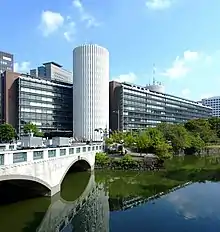Shōji Hayashi (林 昌二, Hayashi Shōji) (23 September 1928 – 30 November 2011)[1] was a Japanese architect. As chief architect of Nikken Sekkei, Ltd.,[2] he designed many notable buildings, including the Palaceside Building in Tokyo, which was selected as one of 20 works of modern Japanese architecture by Docomomo Japan. He was chairman of the Japan Institute of Architects (1990–1992)[3] and an honorary fellow of the American Institute of Architects.[4]
Career
Hayashi was born in Tokyo. He studied architecture under Seike Kiyoshi at the Tokyo Institute of Technology. After graduating in 1953, he joined Nikken Sekkei, Japan's largest independent architectural design firm, where he was chief architect for many years and later Vice President and Vice Chairman.[2]
Notable works

- San'ai Dream Center (1963)[5]
- Palaceside Building (1964)[6]
- Nagano Prefectural Shinano Art Museum (1964)
- Pola Gotanda Building (1971)
- IBM Japan Headquarters Building (1971)
- Nakano Sun Plaza (1973)
- Shinjuku NS Building (1982)
- Toyota Automobile Museum (1989)
- NEC Supertower (1990)
- Kakegawa City Office (1996)
- Bunkyo Civic Center (2000)
- Pola Museum of Art (2002)
Notes
- ↑ "Hayashi Shōji" 林 昌二 (in Japanese). Nikkei Architecture. Retrieved 17 August 2017.
- 1 2 "Hayashi Shōji" 林 昌二 (in Japanese). Tokyo National Research Institute for Cultural Properties. Retrieved 17 August 2017.
- ↑ "Hayashi Shōji" 林 昌二 (in Japanese). Japan Institute of Architects. Retrieved 17 August 2017.
- ↑ Cramer, James P.; Yankopolus, Jennifer Evans (2006). Almanac of Architecture & Design 2006. Greenway Communications. p. 250. ISBN 978-0-9755654-2-1.
- ↑ "San'ai Dream Center". Tokyo Architecture Info. Archived from the original on 2014-09-09. Retrieved 17 August 2017.
- ↑ "Palaceside Building". Docomomo Japan. Retrieved 17 August 2017.
External links
- INAX REPORT No.173 Book review and essay on Hayashi, with conversation between Hayashi and architect Naitō Hiroshi (in Japanese)
![]() Media related to Shoji Hayashi at Wikimedia Commons
Media related to Shoji Hayashi at Wikimedia Commons